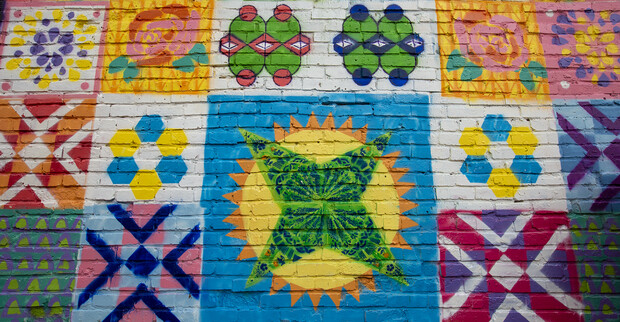
In a semester weighed down by the global pandemic, 16 University of Nebraska–Lincoln honors students have found sanctuary learning about and experiencing community-based art.
Led by Sandra Williams, associate professor of art, the course—“Art, Activism and Community” (listed as UHON 395H)— features in-person instruction, in-depth discussions on difficult topics and hands-on experiences creating collaborative art across Lincoln.
“I made a comment at the start of the semester that I’m not an artist,” said Shelby Castle, a junior double-majoring in biochemistry and mathematics. “But, this class has showed that I can do art, that it’s not super impossible for me.
“Dr. Williams pulled me from my comfort zone and now, I’m looking at art differently.”
Class assignments — which included a learning to crochet for a yarnbombing project, storytelling, and working with middle schoolers to create sidewalk art — peaked April 17 with the creation of a quilt-block mural on the side of a building in Lincoln’s historic Havelock neighborhood.
As hundreds of cars rolled down a nearby street, the students applied spray paint over hand-cut stencils to create the mural. Working in pairs, the students designed the two-foot by two-foot stencil patterns, then came together as a class to adjust individual concepts and refine the mural’s repeating pattern.
“All of the designs are unique, but they class worked together to make sure the end result was unified,” Williams said. “It was incredible to see it all come together.”
As the teams took turns applying their designs, students stood back (in masks), chatted and reflected on the semester.
Josh Harris, a biological sciences (pre-medicine) major from Bellevue, said the course — while challenging — quickly became a sanctuary from the pressures of the semester and COVID-19.
“Our first project was crocheting granny squares — something I have never done before and had to learn from scratch,” Harris said. “It was challenging, but that was when this class became a wonderful escape — a sanctuary where, for two 75 minute classes each week, I was encouraged to be socially engaged, learning about and creating art for the community.”
Sophie Newman, a junior and management major from Omaha, said she relished the opportunity to discuss and create art.
“This was really my first opportunity since high school to be involved in the arts,” Newman said. “I’ve enjoyed that opportunity and I love how this mural is now a part of the Lincoln community. For me, this course has been refreshing — a chance to stretch my skills and experience so many things that I may not have the opportunity to do again in a future career.
“It has been the best part of my semester.”
The course was also only offered as an in-person experience — something that the students enjoyed when many other courses this semester have operated in a hybrid model that allowed students to decide if they would attend in a classroom setting or via video conferencing.
“This was my only in-person class this semester and it became my opportunity to get out of my room, be in an actual classroom, have meaningful conversations face-to-face and experience art,” Castle said. “The collaboration has been awesome and an opportunity to make connections that I never would have made outside of my STEM classes.
“It’s truly made me break out of my shell a bit and given me a whole new perspective on art.”
While students learn the basics of technique and theory, Williams said that an increased appreciation for art is the intention of the course.
“My hope is that these students — who are our future leaders and policymakers — understand how art, regardless of if it is on a sidewalk or hung in a museum gallery, benefits the community and our society,” Williams said. “I also want them to realize that everyone is creative and that there is real joy in coming together to create art.”
--Written by Troy Fedderson, University Communication